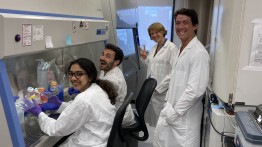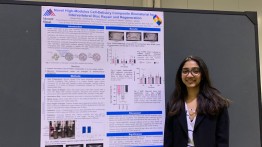Biomedical Partnership Bolsters Real-World Connections
POSTED ON: August 7, 2023
Traveling uptown to conduct research at Mount Sinai during his senior year at Cooper was a pivotal moment for Tyler DiStefano, a 2015 mechanical engineering graduate. Thanks to a collaboration facilitated by one of his professors, DiStefano was able to nurture his interest in biomedical engineering while working in a major hospital research facility.
“I hadn’t engaged in that type of research before,” he says. “The experience really showed me the capabilities of an R1 institution.” In fact, it inspired him to later return to Mount Sinai to earn his Ph.D. in biomedical sciences. “I went back because it was such a great fit.”
DiStefano is not the only one who has followed a path between the two institutions. In 2018, a joint research and educational exchange was established, allowing Cooper engineering students to apply to work with graduate researchers and faculty in the Icahn School of Medicine at Mount Sinai (ISMMS) and providing options for earning course credit. A bioengineering minor was introduced to the engineering curriculum in 2021, and since then, external collaborations on biomedical research have broadened considerably, so much so that Cooper alumni who pursue an advanced degree from ISMMS—like DiStefano— have often served as mentors for Cooper students participating in the exchange.
For Chris Panebianco ChE’16, who earned his Ph.D. in biomedical sciences from ISMMS last year, working with Cooper undergraduates helped bridge his research and his passion for education. “I applied for the NIH [National Institutes of Health] F31 Fellowship as a grad student, expressing my interest in teaching,” he says. “They told me, if you really want to teach, you shouldn’t be doing it at Mount Sinai because there is no undergraduate population, and you won’t get the experiences you need.” James Iatridis, Panebianco’s advisor and a professor in the Department of Orthopedics at ISMMS, suggested he reach out to Jennifer Weiser, an assistant professor in the Department of Chemical Engineering in the Albert Nerken School of Engineering.
“It was one of the best decisions ever,” Panebianco says. He wound up assisting with Weiser’s biomaterials course at Cooper, providing the opportunity to translate ideas from his doctoral research into forms of inquiry-based learning for Cooper students. “Undergrads would then become interested in the project I was working on and want to get involved in the research,” he says.
The Mount Sinai exchange allowed Sanjna Rao ChE’22, for example, to participate in NIH-funded research on injectable biomaterials with Panebianco. Rao, who is currently pursuing her own Ph.D. in biomedical engineering at the University of Delaware, served as the second author on the manuscript that Panebianco published in the journal Biomaterials. Additionally, the work served as a major part of Panebianco’s dissertation for his degree from Mount Sinai. “It’s a testament to how much work Sanjna put into it and how talented and motivated she is,” he says. “She gained two years of research experience and was able to go straight from undergrad to a Ph.D.”
DiStefano, who joined life sciences consulting firm Charles River Associates in 2021, had a similarly beneficial experience, first as a Cooper undergrad himself—collaborating with Eric Lima ME'02, the inaugural Distinguished Professor of Bioengineering at Cooper, and Kevin Costa, associate professor in the Department of Cardiology at ISMMS—then as a Ph.D. researcher under Professor Iatridis. “More Cooper students started applying to the Mount Sinai exchange in the first few years of my Ph.D., and I saw it as an opportunity to give back,” he says.
While working in Iatridis’s lab, DiStefano mentored Keti Vaso ChE’19 M.Eng’21, at the time one of Weiser’s master’s students, on research related to injectable biomaterials as a treatment for intervertebral disc degeneration. “The Cooper exchange gives undergrads not just the research, but the chance to carry out the research in the right environment, in a facility that wouldn’t be available at a small school like Cooper,” says DiStefano.
Panebianco, who has continued to collaborate with Weiser on STEM pedagogy and outreach, adds that the exchange is equally beneficial for the Mount Sinai graduate students. “If I had not had those experiences, it would not have set me up to be where I am now,” he says. As a postdoctoral researcher at the University of Pennsylvania, Panebianco is part of the Institutional Research and Academic Career Development Award [IRACDA] program, an NIH-sponsored initiative whose aim bears similarities to the Cooper–Mount Sinai partnership. It enables him to conduct intensive research at an R1 institution while pursuing teaching relationships with undergraduate programs.
“The model that Cooper and Mount Sinai developed is something I’m involved in now in a more formalized way, bringing all these pieces of research and teaching together.” he explains. “At Penn, I conduct research in the mechanobiology of bone development. Then I will teach STEM coursework at Rutgers University–Camden, a primarily undergraduate institution that has a high population of underrepresented minorities in STEM. My extra goal is to use these courses to get students excited about my research and recruit them to research at Penn. Similarly, I’m developing outreach modules with Jen [Weiser] and the Center for Engineering Mechanobiology at Penn to inspire students from other universities to pursue mechanobiology research.”
Another key aspect of the Cooper Union–Mount Sinai exchange is an annual research symposium. Held in-person at Mount Sinai in its first year, the event moved online because of the pandemic and has since remained virtual. “We discovered that the virtual format works really well,” explains Weiser. “It’s a great way to make internal connections and to see what colleagues at both Cooper and Mount Sinai are working on. Because of that, more and more people have gotten involved.”
The 2022 symposium, for which Panebianco gave the keynote address, was held in October and drew 60 attendees. His talk highlighted the evolution of the Cooper Union–Mount Sinai program, which now includes several undergraduates who are undertaking research with faculty members at both institutions. Weiser, Panebianco, and Iatridis have even recently co-authored engineering education-focused research with Cooper undergraduates, publishing work in the journal Biomedical Engineering Education with students Poorna Dutta ChE’22, Jillian Frost ChE’22, Angela Huang ChE’22, and Olivia Kim ChE’23.
“The program is continuing to grow and giving students opportunities to tap into this research infrastructure,” says Panebianco. “If they’re hungry for it, they can get the research experience they need.”






